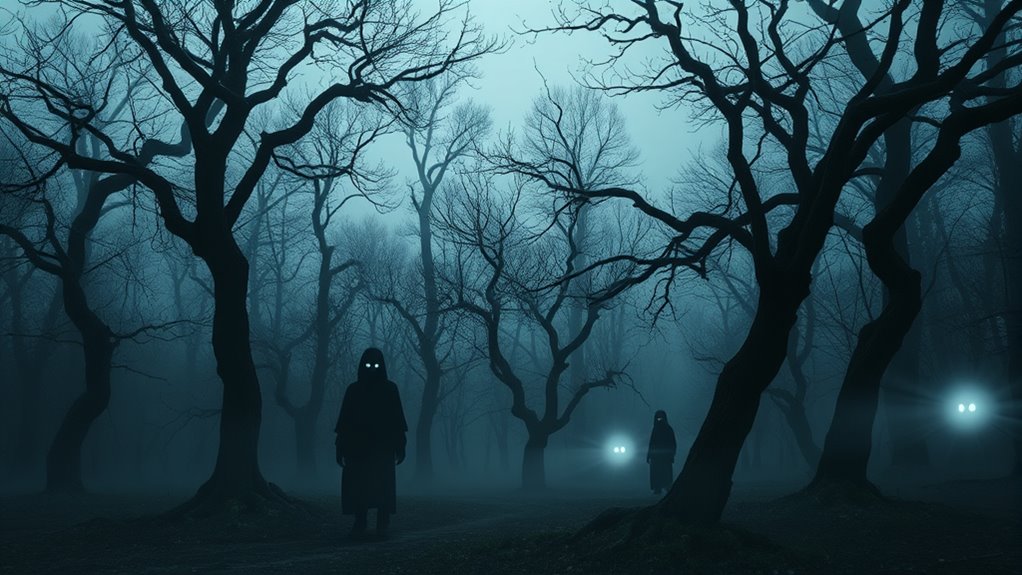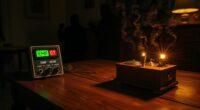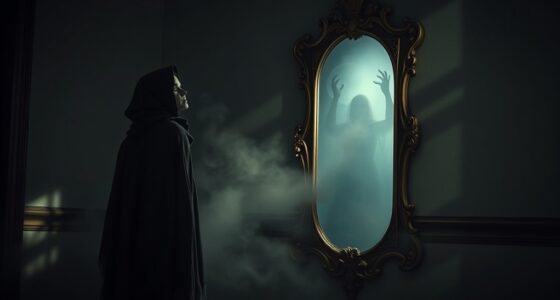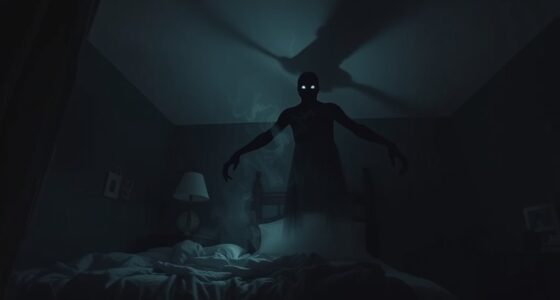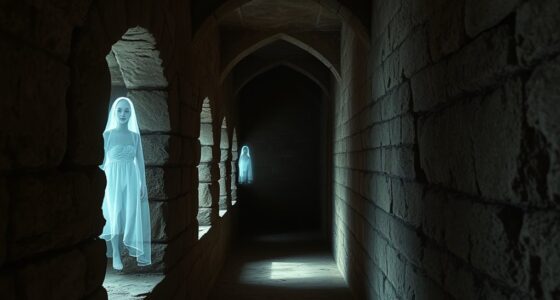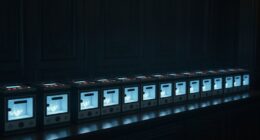When you experience ghostly sightings, your mind often interprets ambiguous sensory cues based on fears, beliefs, or environmental factors like darkness and noise. Sleep paralysis can cause vivid hallucinations, making you see shadowy figures or feel a presence. Confirmation biases and pattern recognition tendencies further influence your perceptions, turning ordinary stimuli into supernatural stories. Understanding these psychological and physiological processes can help demystify these fears—if you keep exploring, you’ll uncover how your mind creates these eerie experiences.
Key Takeaways
- Ghost sightings often result from sleep paralysis, hallucinations, and the brain’s attempt to interpret ambiguous stimuli as spirits.
- Cognitive biases, such as belief in spirits and confirmation bias, influence perception and reinforce ghost-related experiences.
- External factors like lighting, environment, and psychological states can distort sensory input, creating false perceptions of ghosts.
- The brain’s pattern recognition and threat detection tendencies can produce vivid, ghostly images from misinterpreted sensory signals.
- Understanding neurological and psychological processes shifts explanations of ghost sightings from supernatural to scientifically grounded phenomena.
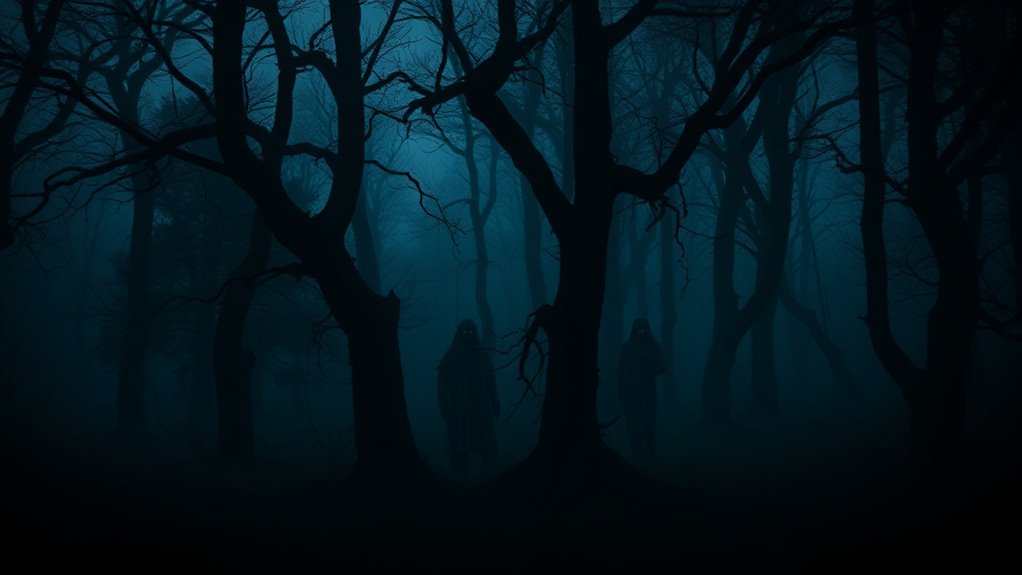
Many people report seeing ghosts, but these sightings often stem from psychological factors rather than actual supernatural encounters. One common experience that can cause ghostly visions is sleep paralysis. During sleep paralysis, you find yourself unable to move or speak while falling asleep or waking up. This state can be terrifying, especially when you see shadowy figures or feel a presence in the room. These hallucinations aren’t supernatural; they result from a breakdown in the boundary between sleep and wakefulness. Your brain, in its vulnerable state, produces vivid images and sensations that feel real, leading to ghostly encounters that are primarily rooted in your mind’s physiology.
Another key factor influencing ghost sightings is cognitive biases. Your mind tends to interpret ambiguous stimuli based on pre-existing beliefs or fears, which can distort your perception of reality. For example, if you already believe in spirits or have been exposed to ghost stories, your brain is more likely to interpret strange sounds or shadows as paranormal. This confirmation bias reinforces your belief, making you more prone to seeing or sensing ghosts in situations where there’s actually a logical explanation. Additionally, the availability heuristic plays a role—if you’ve recently read about ghost encounters or watched horror movies, those ideas are fresh in your mind and can influence how you interpret mysterious phenomena. Furthermore, understanding how eye patches provide temporary relief for tired eyes can help explain how the brain’s perception can be influenced by external aids, much like how psychological factors shape ghost sightings. Recent research into brain activity during hallucinations reveals that similar neural pathways are activated, illustrating how the mind constructs these vivid experiences. Your brain is wired to find patterns and assign meaning, especially in uncertain situations. When you’re alone in a dark house or feeling anxious, your cognitive biases can amplify minor stimuli—like creaking floors or flickering lights—transforming them into convincing ghostly apparitions. These biases serve a purpose, often rooted in evolutionary psychology, helping you be alert to potential threats, but they can also lead you astray by convincing you that you’re experiencing supernatural activity.
Both sleep paralysis and cognitive biases demonstrate how your mind can create convincing but false perceptions of spirits. They show that what you see or feel isn’t necessarily evidence of ghosts but rather a complex interaction of neurological and psychological processes. Recognizing these factors can help demystify many ghost sightings, shifting the focus from supernatural explanations to understanding the powerful influence of your brain. External factors, such as visual perception distortions, further illustrate how your senses can be deceived under certain conditions. Recent advances in AI security research also highlight that our perceptions and interpretations can be influenced by external systems and biases, emphasizing the importance of understanding these processes. Moreover, understanding how sensory integration works can shed light on why conflicting signals from our senses contribute to hallucinations. Ultimately, most ghost encounters are less about spirits and more about how your mind interprets and misinterprets the world around you.
Frequently Asked Questions
Can Ghosts Influence Our Mental Health Negatively?
Ghosts can influence your mental health negatively by affecting your paranormal perception, making you more likely to interpret normal experiences as supernatural. This heightened perception can lead to psychological trauma, especially if you’re already vulnerable or anxious. Fear and stress from believing in ghosts may cause sleep disturbances, paranoia, or panic attacks. Recognizing these effects helps you understand how beliefs in the paranormal can impact your mental well-being.
How Do Cultural Beliefs Shape Ghost Sightings?
Imagine walking through a foggy night, where shadows flicker and whispers echo. Cultural beliefs shape what you perceive, turning vague shapes into ghostly figures based on your cultural narratives and belief systems. These stories influence your mind’s interpretation of unexplained phenomena, making sightings more vivid or frightening. Your cultural background acts as a lens, coloring your experience and shaping how you see and interpret ghostly encounters.
Are Children More Prone to Perceiving Ghosts?
You might notice children are more prone to perceiving ghosts because their childhood imagination and developmental perception are still forming. Their vivid imaginations can blur the line between reality and fantasy, making them more likely to interpret ambiguous stimuli as supernatural. As their brains develop, they become better at distinguishing between real and imagined experiences, so older children and adults are less likely to perceive ghosts compared to younger kids.
What Role Does Sleep Paralysis Play in Ghost Encounters?
Did you know that about 8% of people experience sleep paralysis at some point? Sleep paralysis often causes vivid hallucinations, which can feel like ghost encounters. During these episodes, your mind becomes a hallucination trigger, blending reality with imagined figures. This state’s intense sensory experiences can make you believe you’ve seen spirits or ghosts, but it’s simply your brain’s way of processing fear and sleep disruptions.
Can Technology Help Verify Ghost Sightings Scientifically?
You wonder if technology can verify ghost sightings scientifically. While digital evidence like cameras and audio recorders can capture unexplained phenomena, their effectiveness is limited by current technological limitations. You should know that these tools often can’t distinguish between genuine paranormal activity and natural causes or hoaxes. So, although technology offers some help, it can’t definitively prove or disprove ghost sightings, leaving much room for skepticism.
Conclusion
As you step away from these ghostly tales, remember that your mind is a powerful tool, capable of conjuring spectral figures even in the absence of spirits. Just like an ancient lighthouse guiding ships through fog, your subconscious illuminates fears and beliefs, making you see what isn’t really there. So next time you feel a chill or hear a whisper, consider it might be your mind’s way of playing an elaborate game—no need for haunted castles or séance rooms.
